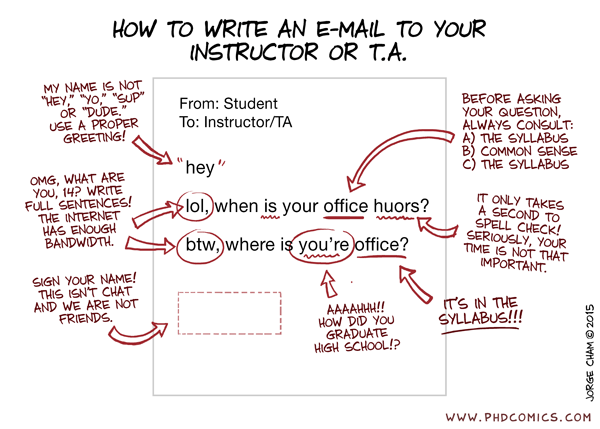OK, so you’ve identified some papers that you should read (or just want to read). Now what? A scientific paper isn’t like a novel. You can’t usually make one quick pass through it and expect to get all the details. However, you may not need to. In fact, you may not need to read most of it at all. How do you decide where to focus your reading? That is the question I will tackle in this blog post.
Why are you reading this paper?
That’s the very first question you need to answer. You will read a paper very differently depending on what you are trying to get from it. Here are some reasons for reading a paper, and some notes on how that might affect your approach to the paper:
- You’re “reading around” your research topic, to get some perspective. If that’s the case, you might be able to skip a lot of the technical stuff and focus on the parts of the paper (introduction, discussion, conclusions) where the authors explain what they have learned and how it fits into the bigger picture.
- You’re trying to look up a particular piece of information. Depending on the nature of that piece of information, you might be able to just quickly scan the paper for it. In the end, you might look at the figures and tables, and maybe read a few paragraphs where a particular result is presented and discussed.
- You want to find out about a technique. Unless the whole paper is about that technique, you might be able to focus relatively narrowly on the methods section and the few paragraphs where the authors explain how they used this technique and what they got from it.
Types of papers
There are lots of different types of papers, but a useful first division is to separate the primary research literature from reviews and commentaries. The primary research literature provides reports of (hopefully) new scientific studies. Reviews and commentaries on the other hand try to put previously published research into some sort of context. Typically, if you’re going to read a review paper, it’s because you want to get a well-rounded picture of some area of research. You would usually read a review from front to back. Because they are intended to explain and summarize some area of research, review papers are usually easier to read than the primary literature. The trade-off is that you’re getting one person’s (or a group’s) view of the field, which at times can be quite biased. In any event, reading review papers doesn’t pose the kinds of challenges nor require the kinds of decisions you have to make when reading the primary literature. The rest of this post focuses on issues that arise when reading papers from the primary literature.
Anatomy of a paper
A scientific paper consists of several, more-or-less standard parts. There’s a bit more variation in theoretical papers than in experimental papers, but at least some of this structure remains in the former. It’s important to understand the purpose of each of these sections in order to read papers efficiently.
All papers start with a title and authorship information. A good title ought to tell you a lot about the main message of the paper, but the truth is that there are plenty of good and useful papers with bad or useless titles. A good title might catch your attention, but an uninformative title shouldn’t necessarily stop you from reading on. In other words, don’t judge a paper by its title.
The title and authors are generally followed by an abstract (not always labeled as such) which is a (usually) one-paragraph summary of the article. Here, the authors are telling you what they think is important in their article. Always read the abstract, no matter why you’re reading the paper. The abstract helps you understand the authors’ perspective on their work, and may point out additional points of interest you can look for in the paper other than what you were hunting for.
Almost all papers start with an introduction which, again, may not be titled as such. The introduction sets the stage for the rest of the paper. It provides background, and therefore typically contains a lot of references, which can be useful when you’re coming up to speed on a topic. It explains the problem the authors hope to solve. Most introductions also provide a brief overview of the paper, right at the end before the main body of the paper starts. As a rule, you want to read the introduction, if for no other reason than that it often functions as a mini-review of the field. The one exception might be the case where you’re looking for a very specific piece of technical information, in which case you might skip the introduction. Even in the latter case, you might want to look for the overview at the end of the introduction since this might help you find what you are looking for a bit faster.
Traditionally, the introduction of an experimental paper was followed by a materials and methods section. Some journals put this section at the end of the paper rather than after the introduction, and some only contain a summary of the methods, with the details appearing in online supplementary materials. Theory papers often don’t have a methods section. Rather, the methods are discussed in the body of the paper since they’re not easily separated from other aspects of the work. You will often skip the methods section, unless you’re there to learn one of the methods used in the paper. Why? If the authors have done a good job of writing the rest of the paper, they will tell you (at least in general terms) what experiments they did as they are describing their results. Moreover, the methods often don’t make all that much sense disconnected from the reason for performing the experiment. If you find that the descriptions of the experiments in the text are not sufficient for your purposes, you can always go look at the methods later.
The main part of the paper will be taken up with a description of what was done and what we can conclude from that, possibly intermixed with a broader discussion of significance. While some journals insist on a clearly labeled Results section, others allow more latitude in dividing up this part of the paper into sections with titles that describe the topic(s) they attack. Depending on why you are reading a paper, this may be a section you read really carefully, one that you skim to find a specific fact, or one that you skip altogether. Nine times out of ten you will read most of this section, since this is where the new science is described, and reading about the advance made in a paper is the usual reason for reading the primary literature. When would you skip the results section(s)? Mostly this would be the case when you’re just acquiring background information, in which case you might just read the introduction and conclusions. Of course, a good review paper or two might be a better way to pick up background information, but there isn’t review paper to cover every possible topic.
The conclusions section is where the authors wrap up: They present their major findings, indicate how those findings do or don’t support one or another hypothesis, and often present some idea of how they think the area of research might evolve from there. Like the introduction, this section usually tries to give us a broader context, so it typically contains quite a few references. The conclusions are often worth reading for that reason alone. More than that, they summarize the technical work that came before, often in much simpler language, so the conclusions can help you understand what, from the authors’ perspective, their work contributes to the field. You will almost always read this section carefully.
Hard papers
Many scientific papers are hard to read, for a variety of reasons. One of the things that often hampers readability is that the work presented is highly technical, so it’s hard for a non-expert to follow for lack of relevant expertise. It’s important not to get discouraged when you feel a bit lost while reading a paper. It’s a common feeling and, unless you really need to understand a paper in depth, which is sometimes necessary for key papers very close to your area of research, it’s often just fine not to get every detail. If you’re really having trouble following the detailed argument in the results section, at least try to understand the general flow of the argument. Failing that, concentrate on the introduction and conclusions, which will tell you what the authors wanted to do and what they claim to have accomplished.
Papers containing mathematical content are a very special subset of hard papers. Here’s a little secret: Unless you are reading a paper to find out how someone proved a particular theorem, you can almost always skip all the proofs. Moreover, you can often skim the equations rather than reading them carefully. A well-written mathematical paper will tell you why certain equations are being derived, which ones are important, what they tell you, and so on. There may only be one or two particularly important equations you need to look at carefully. There may not be any equations worthy of careful scrutiny. Again, it all depends on what you’re hoping to get from the paper. The conclusions obtained from the equations, which will be described in text, may be all you need to know. Alternatively, you may be interested in the final equation obtained, but not in the detailed derivation or proof. We thus come back to the point that you have to have a fairly clear idea of why you are reading a paper.
Figures and tables
Figures and tables, especially if they are accompanied by a good caption, are sometimes worthy of your attention, and sometimes much less so. In some papers, the figures practically tell the whole story: how variable A is related to variable B, the results of key experiments, and so on. They’re generally worth a look, with the caveat that it may happen that you hit a figure you simply don’t understand, perhaps because the interpretation of the figure requires technical knowledge you simply don’t have. When that happens, deal with it as you do with text you don’t understand: If it’s really important to you, work at it or find someone to explain it to you. If not, skip it.
Results tables (as opposed to tables that give the parameters of an experiment) are usually worth a look, too. Papers contain many more figures than tables. If the authors included a table, it’s probably because the data in that table are inherently important or, at least, interesting. Even if you don’t need it now, make a note of papers that contain data tables since you may need those data at some point in the future.
Summary
I would summarize this blog post as follows:
- Think about what you want to get from a paper before you sit down to read it, and focus your reading on the part(s) of the paper most likely to give you what you want.
- Don’t worry about parts of the paper you don’t understand, unless the part you don’t understand specifically addresses your reason for reading the paper.
- The parts of the paper where the authors give you their perspective, mostly the introduction and conclusions, but possibly other sections with extensive interpretive comments, are often the most valuable parts of a paper.

